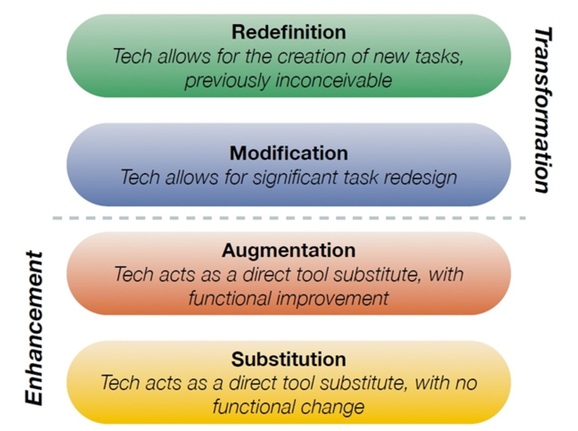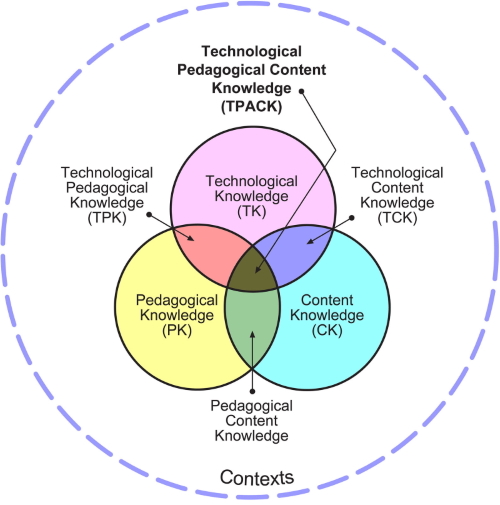
Return to Digital Literacy Web Agenda
What is the SAMR model? Created by John Spencer |
January 25, 2022
- Log in and go to While You Are Waiting for attendance and other activities (e.g., edPuzzle)
- Wrapping up with National and NC Standards for Teachers and Students in our shared Google Docs area
EDMG 466 Google Docs https://drive.google.com/drive/folders/1glXZJohCmyzslzJ2w3B7_nV_kpWdPbar?usp=sharing EDEL 446 Google Docs https://drive.google.com/drive/folders/1eMywzBDX82I6ZjOJvqYphUse4KCR_wx5?usp=sharing
- Setting up your Google Site for the Web 2.0 Assignment Profiles You'll do this semester. We'll complete this together to set up the "Shell" for your pages for each of the five Web 2.0 Tool Profiles with Example assignments. Let return to your Google Sites.
- HOMEPAGE:
- In a brief paragraph, add your perspectives about technology in education.
- Add another short paragraph about yourself (major, career aspirations, where you're from, anything you wish to share "publically")
- SCAFFOLD? Need a walk-through later? See https://vimeo.com/509935317 (password: sitesetup)
- CHALLENGE?
Explore these options in Google Sites:
- From Insert menu (on right): Layouts, Collapsable Text, Image Carousel, Add Google tools (e.g., forms, slides)
- From Page menu (on right): Create dropdown menus with "Sub-pages"
- Moving on to some technology models: These models help inform our work to be CRITICAL THINKERS and INFORMED DECISION MAKERS and is professional knowledge that will help you as a teacher-scholar.
- SAMR: Another way to think about how teachers and students use technology.
Let's review from the video what SAMR stands for

Image the creation of Dr. Ruben Puentedura, Ph.D. http://www.hippasus.com/rrpweblog/
ACTIVITIES:
[Whole Group] Let's explore some examples:
http://www.emergingedtech.com/2015/04/examples-of-transforming-lessons-through-samr/
[Fruit Groups] Choose a topic that you might teach your students. Check out the standards if you wish. Think of the traditional way of teaching this topic/standard and then an alternative that is either M (modification ) or R (redefininition) which uses technology in a more transformative way. Consider the tools we've used so far in class or others you've seen or used yourself.
- ELA Standards https://www.dpi.nc.gov/../media/7228/open
- Mathematics Standards https://www.dpi.nc.gov/../media/4006/open
- Science Standards
- Social Studies Standards (see list by grade level)
- About the TIM :
"The Technology Integration Matrix (TIM) illustrates how teachers can use technology to enhance learning for K-12 students. - The TIM incorporates five interdependent characteristics of meaningful learning environments:
active, constructive, goal directed, authentic, and collaborative.
- The TIM associates five levels of technology integration
:
entry, adoption, adaptation, infusion, and transformation
with each of the five characteristics of meaningful learning environments [listed above].
- Together, the five levels of technology integration and the five characteristics of meaningful learning environments create a matrix or grid of 25 cells."
Source: TIM website
- ACTIVITY: [Fruit Groups]
TIM (https://fcit.usf.edu/matrix/matrix/)
- Discover links to lessons and videos in the matrix where type of learning, and level of technology intersect (e.g. Active Learning and Infusion Level)
- From the videos listed, choose one that seems interesting and that you'd like to know more about.
- In addition to the video lesson, you'll see lesson objectives and materials needed (a mini-lesson plan).
- Reflect on whether the lesson is something you'd like to try in your own classsroom. If so, what would you need for it to work with your students? How would you change the lesson to fit your teaching style and your students' needs?
OTHER WAYS TO FIND VIDEO LESSONS:
If you wish to look by grade level, go to: https://fcit.usf.edu/matrix/matrix/grade-level-index/
If you wish to look by subject area, go to: https://fcit.usf.edu/matrix/matrix/subject-area-index/
- Discover links to lessons and videos in the matrix where type of learning, and level of technology intersect (e.g. Active Learning and Infusion Level)
- TPACK: What is it and why might it be useful in understanding how teachers integrate technology in their practice? The key is that the K in TPACK is what ya' know or in other words the teacher's KNOWLEDGE.
TPACK OVERVIEW (Google Slides)

Alan Parkinson from flikr CC-by-nc-2.0
START THINKING.....
For your first Web 2.0 tool example and profile, you'll create something you can use with your students using Padlet, Kahoot, or edPuzzle. Ask your CE or the host teacher at TCS what might be applicable in your classroom or the students you are working with as this should be an authentic use and an efficient use of your time as well (e.g., double dippin').
ADDITIONAL RESOURCES
View three videos to give you an overview of SAMR, TPACK, and the three compared, SAMR-TPACK-TIM:
SAMR: https://www.youtube.com/watch?v=SC5ARwUkVQg
TPACK: https://www.youtube.com/watch?v=yMQiHJsePOM
SAMR, TPACK, and TIM: https://vimeo.com/231722754 NOTE Password for this video:
techmodels